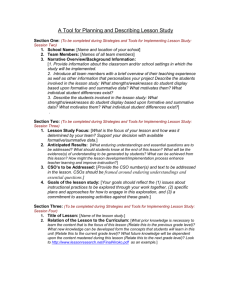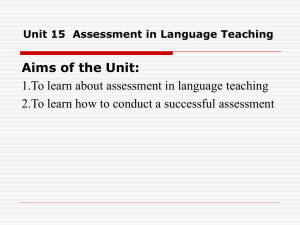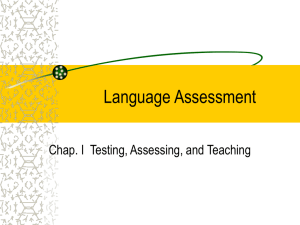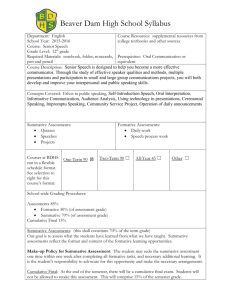How do YOU define “assessment
advertisement
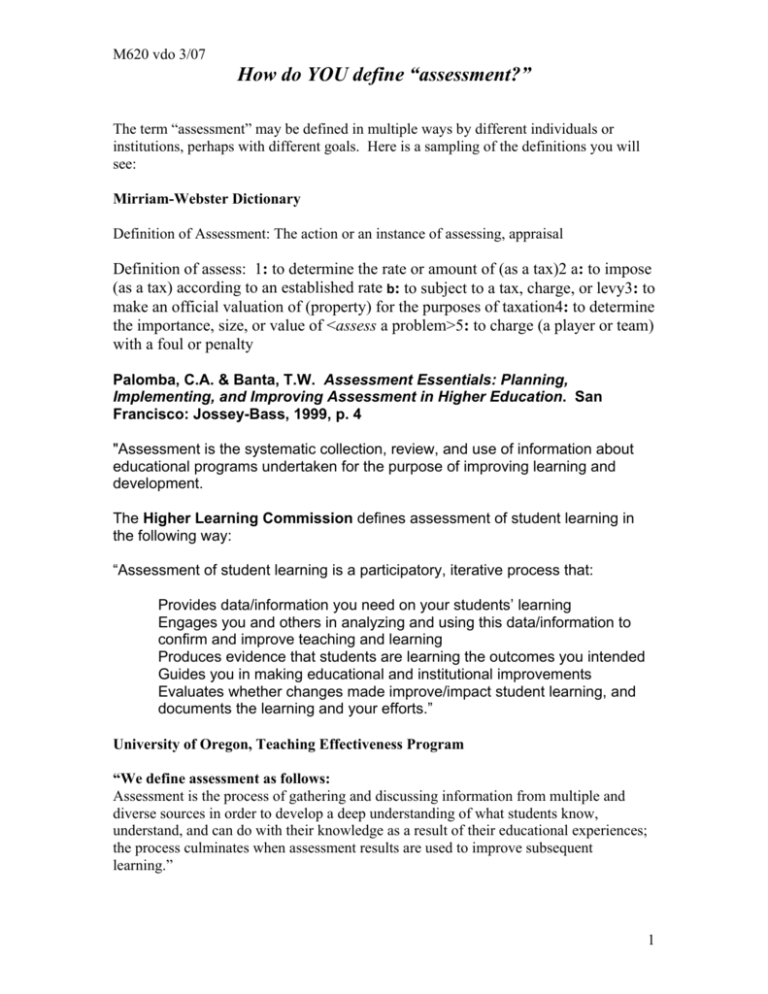
M620 vdo 3/07 How do YOU define “assessment?” The term “assessment” may be defined in multiple ways by different individuals or institutions, perhaps with different goals. Here is a sampling of the definitions you will see: Mirriam-Webster Dictionary Definition of Assessment: The action or an instance of assessing, appraisal Definition of assess: 1: to determine the rate or amount of (as a tax)2 a: to impose (as a tax) according to an established rate b: to subject to a tax, charge, or levy3: to make an official valuation of (property) for the purposes of taxation4: to determine the importance, size, or value of <assess a problem>5: to charge (a player or team) with a foul or penalty Palomba, C.A. & Banta, T.W. Assessment Essentials: Planning, Implementing, and Improving Assessment in Higher Education. San Francisco: Jossey-Bass, 1999, p. 4 "Assessment is the systematic collection, review, and use of information about educational programs undertaken for the purpose of improving learning and development. The Higher Learning Commission defines assessment of student learning in the following way: “Assessment of student learning is a participatory, iterative process that: Provides data/information you need on your students’ learning Engages you and others in analyzing and using this data/information to confirm and improve teaching and learning Produces evidence that students are learning the outcomes you intended Guides you in making educational and institutional improvements Evaluates whether changes made improve/impact student learning, and documents the learning and your efforts.” University of Oregon, Teaching Effectiveness Program “We define assessment as follows: Assessment is the process of gathering and discussing information from multiple and diverse sources in order to develop a deep understanding of what students know, understand, and can do with their knowledge as a result of their educational experiences; the process culminates when assessment results are used to improve subsequent learning.” 1 M620 vdo 3/07 Assessment can be formative or summative (see the following URL: http://www.provost.cmich.edu/assessment/toolkit/formativesummative.htm Formative and Summative Assessment Assessment can be done at various times throughout a program and a comprehensive assessment plan will include formative and summative assessment. The point at which the assessment occurs in a program distinguishes these two categories of assessment. Formative Assessment Formative assessment is often done at the beginning or during a program, thus providing the opportunity for immediate evidence for student learning in a particular course or at a particular point in a program. Classroom assessment is one of the most common formative assessment techniques. The purpose of this technique is to improve quality of student learning and should not be evaluative or involve grading students. This can also lead to curricular modifications when specific courses have not met the student learning outcomes. Classroom assessment can also provide important program information when multiple sections of a course are taught because it enables programs to examine if the learning goals and objectives are met in all sections of the course. It also can improve instructional quality by engaging the faculty in the design and practice of the course goals and objectives and the course impact on the program. Summative Assessment Summative assessment is comprehensive in nature, provides accountability and is used to check the level of learning at the end of the program. For example, if upon completion of a program students will have the knowledge to pass an accreditation test, taking the test would be summative in nature since it is based on the cumulative learning experience. Program goals and objectives often reflect the cumulative nature of the learning that takes place in a program. Thus the program would conduct summative assessment at the end of the program to ensure students have met the program goals and objectives. Attention should be given to using various methods and measures in order to have a comprehensive plan. Ultimately, the foundation for an assessment plan is to collect summative assessment data and this type of data can stand-alone. Formative assessment data, however, can contribute to a comprehensive assessment plan by enabling faculty to identify particular points in a program to assess learning (i.e., entry into a program, before or after an internship experience, impact of specific courses, etc.) and monitor the progress being made towards achieving learning outcomes. References: Angelo, T. A., & Cross, K. P. (1993). Classroom Assessment Techniques: A Handbook for College Teachers (2nd ed.). San Francisco : Jossey-Bass. Bardes, B. & Denton, J. (2001, June). Using the Grading Process for Departmental and Program Assessment. Paper presented at the American Association for Higher Education Conference; Denver , CO . Cliffs notes version: formative assessment is done while the class or learning unit/section is ongoing, summative assessment is done at the end of a class or learning unit. 2 M620 vdo 3/07 What are some examples of formative assessment? Classroom Assessment Techniques (e.g., muddiest point, minute paper, memory matrix) Homework exercises Discussion responses Journal Entries Pretests most formative assessments are designed for timely feedback so as to “tweak” the teaching/learning environment for the better, before the end of a class What are some examples of summative assessment? Exams Papers Journals (when completed for a course) Lab write-ups Both formative and summative assessment are interconnected – an instructor typically will use both types of assessment to gauge learning during and after a class 3



